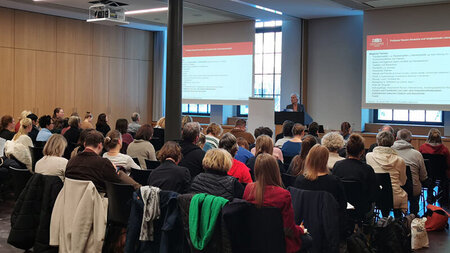Eintrag in der Universitätsbibliographie der TU Chemnitz
Volltext zugänglich unter
URN: urn:nbn:de:bsz:ch1-qucosa2-785960
TiNbOx microscaffolds for studying early bone cell-material interactions in the microscale
Kurzfassung in englisch
Titanium alloys are frequently used in the medical field as bone implant materials due to their excellent biocompatibility and corrosion resistance. Yet, their elastic modulus is usually significantly higher than the one of bone, which can lead to a reduction of bone tissue at the implant site. The current research is therefore focused on the development of highly porous implants, which promise a low elastic modulus close to that of bone, an enhanced bone ingrowth and an improved vascularization. However, the appropriate pore size for an optimal osseointegration still remains unclear. To that end, a transparent tubular microsystem is developed to mimic such a porous microenvironment in order to study single bone cell behavior and early bone formation processes. The system is fabricated out of an implant material (β-stabilized Ti-45Nb (wt%)). It is demonstrated that the bulk material composition, which is consisting of a high Nb content, can be closely transferred to transparent thin films by using reactive sputtering. These films then self-assemble into tubular microscaffolds (TS) with a diameter range between 10-42 μm. Biological studies are subsequently performed to investigate the response (e.g. cell adhesion, migration, osteogenic differentiation) of human Mesenchymal Stem Cells (MSC) to the TS. It is shown that cells form fewer, more diffuse focal adhesion points inside the TS compared to a planar surface and the spatial confinement causes a switch in between amoeboid and mesenchymal migration modes. In addition, it is demonstrated that cells can survive inside the TS for at least 12 days during osteogenic differentiation and partly mineralize the TS interior. The observed mineralization process is furthermore linked to the formation of hydroxyapatite crystals inside dead cells bodies, which leads to a crystallization over time. All in all, the TS platform offers an easy way to identify key factors of bone cell-implant interactions that can be used to improve the biocompatibility of the bone-implant interface in the future.
| Universität: | Technische Universität Chemnitz | |
| Institut: | Professur Materialsysteme der Nanoelektronik | |
| Fakultät: | Fakultät für Naturwissenschaften | |
| Dokumentart: | Dissertation | |
| URL/URN: | https://nbn-resolving.org/urn:nbn:de:bsz:ch1-qucosa2-785960 | |
| SWD-Schlagwörter: | Biophysik , Fotolithografie , Mineralisation | |
| Freie Schlagwörter (Deutsch): | Biophysik , Fotolithografie , Mineralisation | |
| Freie Schlagwörter (Englisch): | tubular microscaffold , bone cells , mineralization , single cell analysis , implant material | |
| DDC-Sachgruppe: | 571.634 | |
| Sprache: | deutsch | |
| Tag der mündlichen Prüfung | 15.03.2022 | |
Bemerkung: |
_MA!N_ |




